29 Jan 2024

Patent Assignment: How to Transfer Ownership of a Patent
By Michael K. Henry, Ph.D.
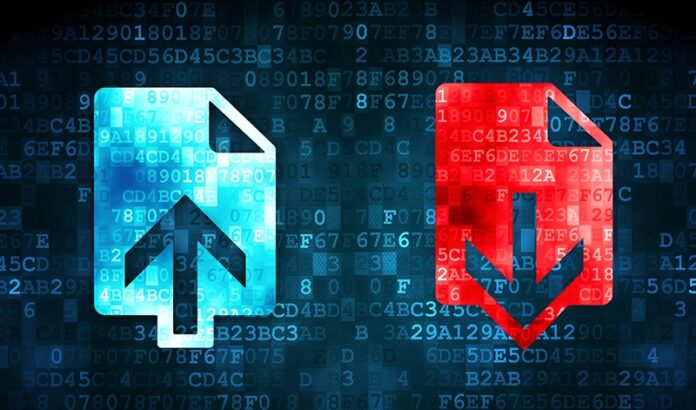
- Intellectual Property
- Patent Prosecution
This is the second in a two-part blog series on owning and transferring the rights to a patent. ( Read part one here. )
As we discussed in the first post in this series, patent owners enjoy important legal and commercial benefits: They have the right to exclude others from making, selling, using or importing the claimed invention, and to claim damages from anyone who infringes their patent.
However, a business entity can own a patent only if the inventors have assigned the patent rights to the business entity. So if your employees are creating valuable IP on behalf of your company, it’s important to get the patent assignment right, to ensure that your business is the patent owner.
In this post, we’ll take a closer look at what a patent assignment even is — and the best practices for approaching the process. But remember, assignment (or transfer of ownership) is a function of state law, so there might be some variation by state in how all this gets treated.
What Is a Patent Assignment and Why Does it Matter?
A patent assignment is an agreement where one entity (the “assignor”) transfers all or part of their right, title and interest in a patent or application to another entity (the “assignee”).
In simpler terms, the assignee receives the original owner’s interest and gains the exclusive rights to pursue patent protection (through filing and prosecuting patent applications), and also to license and enforce the patent.
Ideally, your business should own its patents if it wants to enjoy the benefits of the patent rights. But under U.S. law , only an inventor or an assignee can own a patent — and businesses cannot be listed as an inventor. Accordingly, patent assignment is the legal mechanism that transfers ownership from the inventor to your business.
Patent Assignment vs. Licensing
Keep in mind that an assignment is different from a license. The difference is analogous to selling versus renting a house.
In a license agreement, the patent owner (the “licensor”) gives another entity (the “licensee”) permission to use the patented technology, while the patent owner retains ownership. Like a property rental, a patent license contemplates an ongoing relationship between the licensor and licensee.
In a patent assignment, the original owner permanently transfers its ownership to another entity. Like a property sale, a patent assignment is a permanent transfer of legal rights.
U sing Employment Agreements to Transfer Patent Ownership
Before your employees begin developing IP, implement strong hiring policies that ensure your IP rights will be legally enforceable in future.
If you’re bringing on a new employee, have them sign an employment agreement that establishes up front what IP the company owns — typically, anything the employee invents while under your employment. This part of an employment agreement is often presented as a self-contained document, and referred to as a “Pre-Invention Assignment Agreement” (PIAA).
The employment agreement should include the following provisions:
- Advance assignment of any IP created while employed by your company, or using your company’s resources
- An obligation to disclose any IP created while employed by your company, or using your company’s resources
- An ongoing obligation to provide necessary information and execute documents related to the IP they created while employed, even after their employment ends
- An obligation not to disclose confidential information to third parties, including when the employee moves on to a new employer
To track the IP your employees create, encourage your employees to document their contributions by completing invention disclosure records .
But the paperwork can be quite involved, which is why your employment policies should also include incentives to create and disclose valuable IP .
Drafting Agreements for Non-Employees
Some of the innovators working for your business might not have a formal employer-employee relationship with the business. If you don’t make the appropriate arrangements beforehand, this could complicate patent assignments. Keep an eye out for the following staffing arrangements:
- Independent contractors: Some inventors may be self-employed, or they may be employed by one of your service providers.
- Joint collaborators: Some inventors may be employed by, say, a subsidiary or service company instead of your company.
- Anyone who did work through an educational institution : For example, Ph.D. candidates may not be employees of either their sponsoring institution or your company.
In these cases, you can still draft contractor or collaborator agreements using the same terms outlined above. Make sure the individual innovator signs it before beginning any work on behalf of your company.
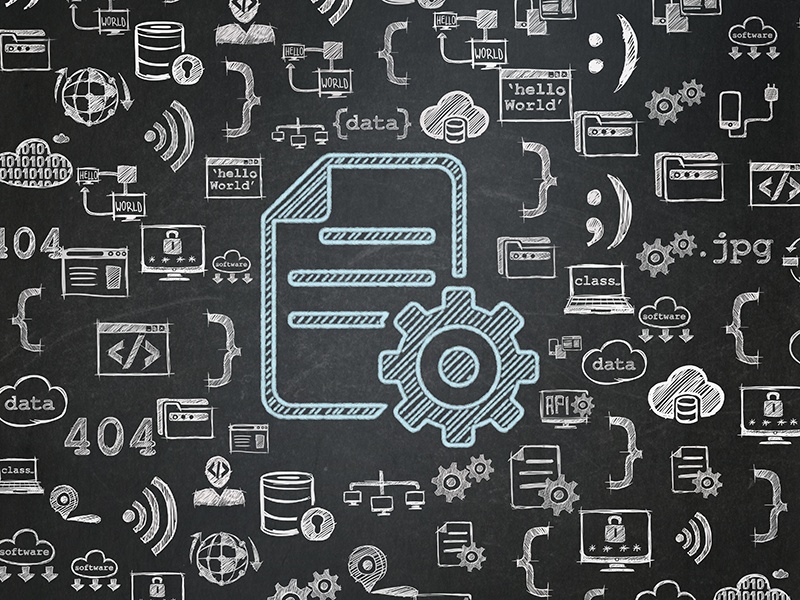
O btaining Written Assignments for New Patent Applications
In addition to getting signed employment agreements, you should also get a written assignments for each new patent application when it’s filed, in order to memorialize ownership of the specific patent property.
Don’t rely exclusively on the employment agreement to prove ownership:
- The employment agreement might contain confidential terms, so you don’t want to record them with the patent office
- Because employment agreements are executed before beginning the process of developing the invention, they won’t clearly establish what specific patent applications are being assigned
While you can execute the formal assignment for each patent application after the application has been filed, an inventor or co-inventor who no longer works for the company might refuse to execute the assignment.
As such, we recommend executing the assignment before filing, to show ownership as of the filing date and avoid complications (like getting signatures from estranged inventors).
How to Execute a Written Patent Agreement
Well-executed invention assignments should:
- Be in writing: Oral agreements to assign patent rights are typically not enforceable in the United States
- Clearly identify all parties: Include the names, addresses, and relationship of the assignor(s) and assignee
- Clearly identify the patent being assigned: State the patent or patent application number, title, inventors, and filing date
- Be signed by the assignors
- Be notarized : If notarization isn’t possible, have one or two witnesses attest to the signatures
Recording a Patent Assignment With the USPTO
Without a recorded assignment with the U.S. patent office, someone else could claim ownership of the issued patent, and you could even lose your rights in the issued patent in some cases.
So the patent owner (the Assignee) should should record the assignment through the USPTO’s Assignment Recordation Branch . They can use the Electronic Patent Assignment System (EPAS) to file a Recordation Cover Sheet along with a copy of the actual patent assignment agreement.
They should submit this paperwork within three months of the assignment’s date. If it’s recorded electronically, the USPTO won’t charge a recordation fee .
Need to check who owns a patent? The USPTO website publicly lists all information about a patent’s current and previous assignments.
When Would I Need to Execute a New Assignment for a Related Application?
You’ll need only one patent assignment per patent application, unless new matter is introduced in a new filing (e.g., in a continuation-in-part , or in a non-provisional application that adds new matter to a provisional application ). In that case, you’ll need an additional assignment to cover the new matter — even if it was developed by the same inventors.
What If an Investor Won’t Sign the Written Assignment?
If you can’t get an inventor to sign an invention assignment, you can still move forward with a patent application — but you’ll need to document your ownership. To document ownership, you can often rely on an employee agreement , company policy , invention disclosure , or other employment-related documentation.
D o I Need to Record My Assignments in Foreign Countries?
Most assignments transfer all rights, title, and interest in all patent rights throughout the world.
But in some countries, the assignment might not be legally effective until the assignment has been recorded in that country — meaning that the assignee can’t enforce the patent rights, or claim damages for any infringement that takes place before the recordation.
And there might be additional formal requirements that aren’t typically required in the United States. For example, some countries might require a transfer between companies to be signed by both parties, and must contain one or both parties’ addresses.
If you’re assigning patents issued by a foreign country, consult a patent attorney in that country to find out what’s required to properly document the transfer of ownership.
N eed Help With Your Patent Assignments?
Crafting robust assignment agreements is essential to ensuring the proper transfer of patent ownership. An experienced patent professional can help you to prepare legally enforceable documentation.
Henry Patent Law Firm has worked with tech businesses of all sizes to execute patent assignments — contact us now to learn more.
GOT A QUESTION? Whether you want to know more about the patent process or think we might be a good fit for your needs – we’d love to hear from you!

Michael K. Henry, Ph.D.
Michael K. Henry, Ph.D., is a principal and the firm’s founding member. He specializes in creating comprehensive, growth-oriented IP strategies for early-stage tech companies.
10 Jan 2024
Geothermal Energy: An Overview of the Patent Landscape
By Michael Henry
Don't miss a new article. Henry Patent Law's Patent Law News + Insights blog is designed to help people like you build smart, scalable patent strategies that protect your intellectual property as your business grows. Subscribe to receive email updates every time we publish a new article — don't miss out on key tips to help your business be more successful.
Patent Assignment: Everything You Need to Know
A patent assignment is an irrevocable agreement for a patent owner to sell, give away, or transfer interest to an assignee, who can enforce the patent. 6 min read updated on January 01, 2024
Updated November 5, 2020:
Patent Assignment: What Is It?
A patent assignment is a part of how to patent an idea and is an irrevocable agreement for a patent owner to sell, give away, or transfer his or her interest to an assignee, who can benefit from and enforce the patent. The assignee receives the original owner's interest and gains exclusive rights to intellectual property. He or she can sue others for making or selling the invention or design.
There are four types of patent assignments:
Assignment of Rights - Patent Issued: This is for patents that have already been issued.
Assignment of Rights - Patent Application : This is for patents still in the application process. After filing this form, the assignee can be listed as the patent applicant.
Assignment of Intellectual Property Rights - No Patent Issued or Application Filed: This is for unregistered inventions with no patent.
Exclusive Rights
Advantages of a Patent Assignment
Assignees don't create a unique invention or design. They also don't go through the lengthy patent process . They simply assume exclusive rights to intellectual property.
Profit Potential
Many patents cover intellectual property that can earn the owner money. A patent owner can charge a lump sum sale price for a patent assignment. After the transfer, the assignee can start to earn profits from the patent. Both original owners and assignees can benefit from this business arrangement.
Disadvantages of a Patent Assignment
Too Many or Not Enough Inventors
Patents can have multiple owners who invented the product or design. Sometimes patents list too many or not enough inventors. When this happens, owners can argue about an incorrect filing. This kind of dispute can make a patent assignment impossible.
Limited Recourse
Older patents may already have many infringements. Not all patent assignments include the right to sue for past infringements. This is known as the right to causes of action. This can cost the assignee a lot of potential profit.
Examples of What Happens When You File a Patent Assignment vs. When You File a Patent License
When You File a Patent Assignment
The patent owner changes permanently. You file the paperwork with the United States Patent and Trademark Office (USPTO). Information about the new owner is available to the public.
Many owners charge a one-time fee for a patent assignment. The original owner doesn't receive additional payments or profits in the future. The new owner receives future profits.
When You File a Patent License
The patent owner doesn't change permanently. Most licenses have a time limit. At the end of the period, the original owner takes control again. Licensing information isn't always available through an online USPTO search. Contact the recordation office directly to get information about patent licenses.
The licensee can assign rights to another person or company. This adds another layer of ownership over the intellectual property.
Many owners charge royalties for a patent license. The licensee pays royalty fees throughout the license period. If the royalty fees are high and the license period is long, a patent assignment may be a better choice for earning the new owner more money.
Common Mistakes
Not Filing an Assignment Document
A verbal agreement is not official. File a patent assignment to change patent ownership.
Taking Action Before Filing
The assignee shouldn't make or sell the invention before the patent assignment is official. If an error or another problem happens, this could be patent infringement .
Making a Filing Error
Patent assignments are official documents. The assignee's name must be legal and correct. Before filing, check the spelling of the assignee name. If the assignee is a business, confirm the legal name. Many patents have more than one owner. List all names on the assignment.
Misidentifying the Patent
Include as much information about the patent as you can. List the patent number and title. Describe the intellectual property completely.
Not Searching for Security Interests
Patents can be collateral. A bank or another party can file a security interest in a patent, and this can limit how much an assignee can earn from a patent. Check for security interests before filing a patent assignment.
Not Filing a Proprietary Information Agreement
Many businesses file patents, as this is part of a business plan , and it's especially common for startup businesses. Inventorship problems can happen if employees file patents instead of the business.
Often, employees have an obligation to assign inventions to a company. This is true if they developed the invention on the job.
To avoid confusion, require employees to sign a proprietary information agreement. This automatically assigns inventions and designs to the business. Other options include signing an automatic assignment or an explicit assignment. These all clarify patent ownership.
Not Being Notarized
Make sure all official documents concerning your patent are notarized. There is a huge legal advantage to being notarized. It makes it so that your documents will be accepted as correct until it is proven otherwise. If you can't get your documents notarized, gather two witnesses. Have them attest to the signatures.
You have to file a patent assignment within three months of signing the form. If you don't, the assignee could lose ownership rights.
Frequently Asked Questions
Where Do I Record a Patent Assignment?
If you have a U.S. patent, record your patent assignment with the USPTO. If you have a foreign patent, file with the correct national patent offices.
I Can't Get a Signature from the Inventor. What Happens Now?
First, it needs to be officially established that:
- Whoever is pursuing the application has the right to do so.
- The inventor cannot be reached.
In order to establish this, the patent office will need a copy of the following:
- the employee agreement
- the assignment
- other evidence of the rights
After that, the patent office will continue as if the signature has been obtained, even though it hasn't.
If the inventor has died, the patent office will try to contact the person in charge of managing the deceased's estate or the heir. If the invented refuses to sign or is missing, the patent office will ask for a declaration from the person who is trying to contact them. They will also look at the following items that have been sent to the inventor:
- Do I Have to File a Patent Assignment if the Owner's Name Changed?
No, you don't need a patent assignment if only the person's or company's name changed. If the company merged with another, you may need a patent assignment.
What if I Make a Mistake on My Patent Assignment?
You can't correct a patent assignment. You have to assign it back to the original owner. Then you have to reassign with the correct information.
How Much Does a Patent Assignment Cost?
The patent assignment fee is $25. Filing electronically doesn't cost extra. You do have to pay an additional $40 fee if you file on paper.
Should I Hire a Lawyer?
Yes, you should get a lawyer to help with a patent assignment. A lawyer will make sure there are no filing errors. A lawyer knows how to describe the patent correctly. Errors and bad descriptions can limit the power of a patent assignment. This could cost the assignee a lot of money in future profits and legal fees.
Steps to File a Patent Assignment
1. Fill Out a Recordation Form Cover Shee t
The Recordation Form Cover Sheet is an official USPTO document. This includes the names of the assignor(s) and the assignee(s). It also includes the patent title and number.
2. Complete a Patent Assignment Agreement
The patent assignment agreement should list the assignor(s) and the assignee(s). It should state that the assignor has the right to assign the patent. It should also describe the intellectual property clearly and completely. It should also explain any financial or other transactions that have to take place. This includes a description of the lump sum payment.
3. Sign the Patent Assignment Agreement
All patent owners and assignees must sign the patent assignment agreement.
4. Submit the Patent Assignment
Finally, submit the patent assignment with the USPTO. You have to pay the assignment fee at this time.
If you need help with patent assignments, you can post your question or concern on UpCounsel's marketplace . UpCounsel accepts only the top 5 percent of lawyers to its site. Lawyers on UpCounsel come from law schools such as Harvard Law and Yale Law and average 14 years of legal experience, including work with or on behalf of companies like Google, Menlo Ventures, and Airbnb.
Hire the top business lawyers and save up to 60% on legal fees
Content Approved by UpCounsel
- Brookfield Patent Lawyers
- Jackson Patent Lawyers
- Katy Patent Lawyers
- Kokomo Patent Lawyers
- Providence Patent Lawyers
- Reno Patent Lawyers
- Southaven Patent Lawyers
- How to Sell a Patent
- Patent Assignment Database
- Patent Companies
- Patent Pending Infringement
- Patent Rights
- Patent Attorney
- What Does a Patent Do
- How to File a Patent
- When Can You Say Patent Pending? Everything You Need to Know
- Atlanta Patent Lawyers
- Austin Patent Lawyers
- Boston Patent Lawyers
- Chicago Patent Lawyers
- Dallas Patent Lawyers
- Houston Patent Lawyers
- Los Angeles Patent Lawyers
- New York Patent Lawyers
- Philadelphia Patent Lawyers
- San Francisco Patent Lawyers
- Seattle Patent Lawyers
- Charlotte Patent Lawyers
- Denver Patent Lawyers
- Jacksonville Patent Lawyers
- Las Vegas Patent Lawyers
- Phoenix Patent Lawyers
- Portland Patent Lawyers
- San Antonio Patent Lawyers
- San Diego Patent Lawyers
- San Jose Patent Lawyers
- View All Patent Lawyers

What is a Patent Assignment?
Whether you’re curious about assigning a patent to someone else or having a patent assigned to you, you might be wondering what a patent assignment is? Patent law allows patent holders to assign patents to other parties. Patent assignments often take place between an employee and his company, however, it’s not uncommon for a person to assign his interest to a patent to a third party. So, what exactly is a patent assignment? We will cover this below.
What is a Patent Assignment ?
A patent assignment is an agreement by the patent holder (assignor) to transfer his interest and ownership of a patent to another party known as the assignee (party receiving patent rights). Once a patent holder executes an assignment agreement assigning his interest in a patent to another party, the assignor loses his rights under the patent. The assignor (transferor) will no longer be able to stop others from using, making, and selling the patent invention. Instead, the assignee gains these rights.
In the United States, patent assignments are very common between an employee and his company because a company or business cannot apply for a patent. An inventor has to apply for a patent and then the inventor then assigns his interest under a patent to the company for which he is working.
An assignment transfers the ownership of the patent from the inventor or employee to the company for which he is working. That said, assignments can also be made by any two parties that agree to transfer ownership of a patent.
So, now we know that a patent holder can transfer his patent rights to a third party, can an inventor assign a pending patent application? Absolutely, yes! An inventor can assign his rights under a pending patent application to another party.
If you’re an inventor and you want to assign your patent to another party, just remember that patent assignments are final. Once an inventor assigns (transfers) his interest in a patent to another party, the assignment (transfer of rights) cannot be undone, it’s final.
What is a Patent Assignor?
A patent assignor is a party that transfers it’s interest and right to the patent to the transferee (assignee) or the party receiving the patent. Once an agreement is executed and recorded with the patent office, the assignee becomes the patent right holder.
What is a Patent Assignee?
A patent assignee is a person to whom the patent rights are transferred to. Said differently, the assignee is the new owner of the patent. An assignee should immediately record an assignment agreement with the patent office to establish his rights as the new patent owner.
Requirements to Execute a Patent Assignment Agreement
For a patent holder to assign (transfer) his interest in a patent to another party, the assignor (person transferring patent rights) must execute a written agreement that includes details, such as the name of the assignor and the assignee, as well as the patent that is to be assigned (transferred) to the assignee.
Once the assignment agreement is executed, it must be filed with the USPTO for the agreement to take effect. Please remember that the agreement needs to be in writing, oral agreements are not sufficient to transfer the rights from the patent holder to the assignee.
The assignment agreement must include the following information:
- The agreement must contain the legal names of both the assignor (person transferring patent rights) and the assignee (person receiving patent rights).
- The agreement must clearly identify the patent by stating the name of the patent, as well as the patent number.
- The terms of the agreement must be included in the assignment agreement.
- Both the assignor(s) and assignee(s) must sign the agreement.
Who Owns the Patent After a Patent Assignment?
Once the assignor and assignee execute an assignment agreement and file the assignment with the USPTO, the assignee owns the patent. As the new patent owner, the assignee will have the right to stops others from using, making, and selling the patented invention for the remaining patent term.
The assignor (person who transferred his rights) loses his rights under the patent and will no longer be able to enforce the patent. Assigning a patent is similar to selling a car and registering the title in someone else’s name. Once the patent is assigned, similar to registering the title of a vehicle in someone else’s name, the new owner is the assignee (person to whom the patent was transferred to). Once the assignment is recorded with the patent office, the records will be updated to show the assignee (new owner) of the patent. This information will then be made available to the public.
Assigning a Patent vs Licensing a Patent
Assigning a patent is much different than licensing a patent. When a patent holder assigns his interest in a patent to another party, he is usually transferring ownership of the patent to the other party. Patent licensing is different in that a license is merely a transfer of the right to use the patent in the manner specified in the licensing agreement. Assignments transfer ownership while a license transfers the right to use the patented invention. That said, if a patent is assigned, the information of the assignor and assignee will become part of the public record. Whereas if an inventor licenses his patent, that information is not typically published to the public.
Does a Patent Assignment Need to be Notarized?
The USPTO does not require patent assignments to be notarized. The patent office only requires that the assignment be executed and signed by both the assignor and the assignee. Once an agreement is executed and signed by the parties, the assignment must be recorded with the patent office.
If the assignee fails to record the assignment, there is nothing to protect the assignee from the assignor assigning the patent to a third party. So, if you’re an assignee, make sure to record your assignment as soon as it’s executed to avoid problems.
Although a patent assignment does not need to be notarized, notarizing it can be beneficial in the event that the previous patent holder claims that he did not make the assignment. It’s an added layer of protection that could prove to be very valuable.
Can Multiple People Own a Patent?
Yes, multiple people can own a patent. For example, if three inventors make a single invention, all three are considered joint inventors and their names should appear on the patent application, as well as the issued patent.
If there are multiple inventors on a patent application, all inventors must execute an assignment agreement to assign each of their interest to the assignee for the assignee to own the entire patent.
For example, if only 1 of 3 inventors assigns his interest, the assignment would be a partial assignment until all 3 inventors each assign (transfer) their interest to the assignee.
Patent Assignment Tips
1) hire an attorney to assist you with your patent assignment.
Any individual who’s either an assignor or assignee should hire an attorney to assist with the assignment of a patent. Attorneys will ensure that the assignment agreement complies with the law and contains all of the information that is required for a successful patent assignment. Although it’s not unheard of for parties to execute an assignment agreement on their own, making a mistake could cause legal troubles down the road.
2) Don’t Forget to Record A Patent Assignment
If you have been assigned a patent, don’t forget to record your assignment with the USPTO. We say this because patent assignments don’t go into effect unless the assignment is recorded with the patent office. Recording a patent assignment tells the patent office that you are the new owner of the patent.
If an assignee does not record the assignment with the patent office, it is as if the assignment never took place. Also, if it’s not recorded, the assignor could possibly assign the patent to a third party. So, make sure to record your assignment as quick as possible.
3) Notarize Your Assignment Agreement
It’s good practice to have an assignment agreement notarized. This helps in a situation where the assignor claims that he did not execute the assignment agreement. In the event that an assignor claims he did not execute the assignment agreement, you will have evidence to show otherwise. The burden may shift to the assignor to prove that he did not execute the assignment agreement. So, notarize your agreement, as well as other documents relating to the assignment of a patent.
4) How Much Does it Cost to Record an Assignment with the USPTO?
It’s currently free to record an assignment with the USPTO if a party submits the assignment electronically. However, if a party chooses to record the assignment agreement by paper, there is a $50 fee for the service. So, record your assignment online if you want to avoid paying anything. That said, you may need to publish your assignment in an official gazette, such publication does cost $25.
Patent Assignment
Let’s do a quick recap. A patent assignment is the transfer of ownership of a patent from one party to another. The party transferring its right is known as the assignor and the party receiving the patent rights is known as the assignee.
To assign a patent, both parties must execute a written assignment agreement to reflect the transfer of ownership. Once the parties execute the agreement, they must record it with the patent office to establish the new ownership. If you have any general questions or comments, please feel free to leave them in the comments section below.
My name is Noah and I love everything about patents and patent law. During my law school years, I studied intellectual property law and took courses in patent law, trademark law, and copyright law. I graduated from Loyola Marymount Law School and obtained my Juris Doctorate in 2014.
Similar Posts

Can You Patent a Supplement Formula?
If you’ve just finished developing an awesome supplement, you might be wondering how you can protect your new supplement formula. The United States Patent and Trademark Office (USPTO) offers inventors…
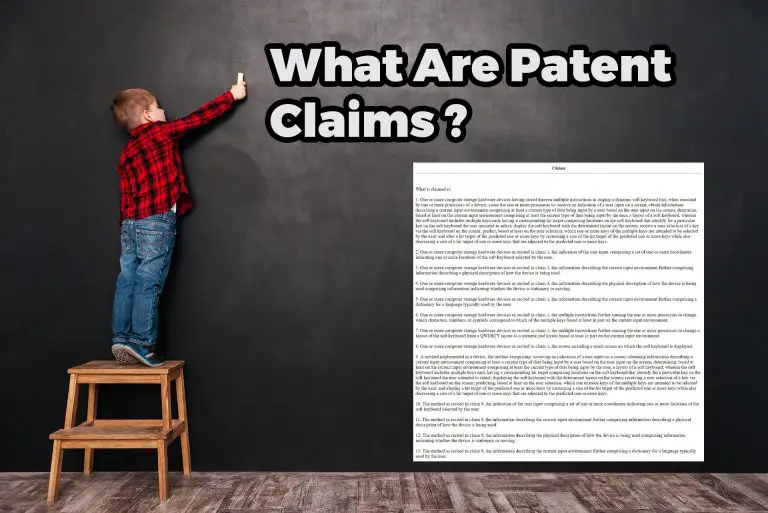
What are Patent Claims?
What Are Patent Claims? Patent claims are arguably the most important part of a patent application. Patent claims set out the aspects of the invention that the patent protects. Patent…

Can You Patent a Song?
If you’ve just finished writing the best song ever, you might be wondering how you can protect your intellectual property (IP). The United States Patent and Trademark Office (USPTO) offers…
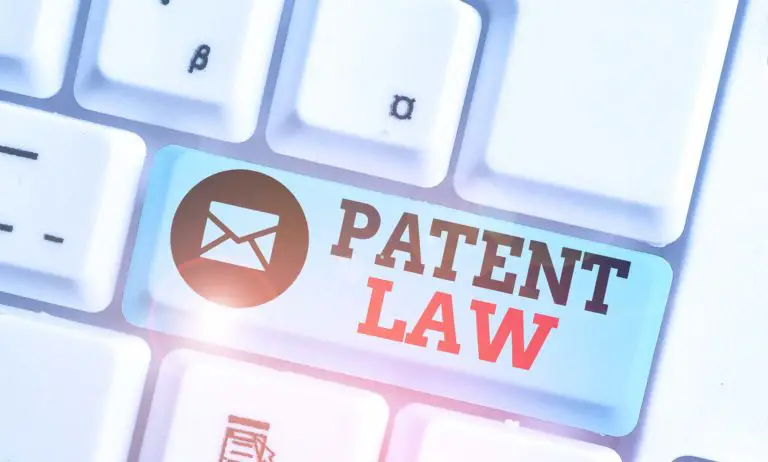
Who Owns the Patent the Company or the Employee?
Who Owns the Patent the Company or Employee? When an inventor makes something or invents something new, there may be some confusion as to who owns the invention, the company…
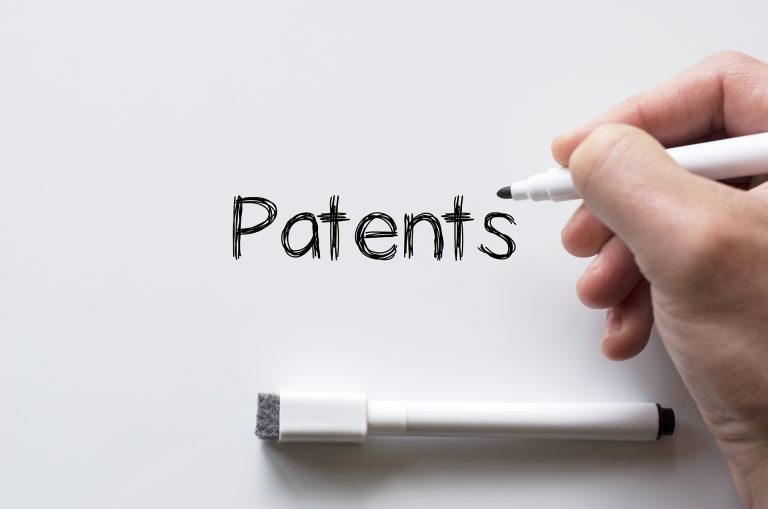
What Are Utility Patents?
Whether you’re an inventor who wants to protect his invention or you’re just interested in learning what a utility patent is, you’ve come to the right spot. The USPTO (United…
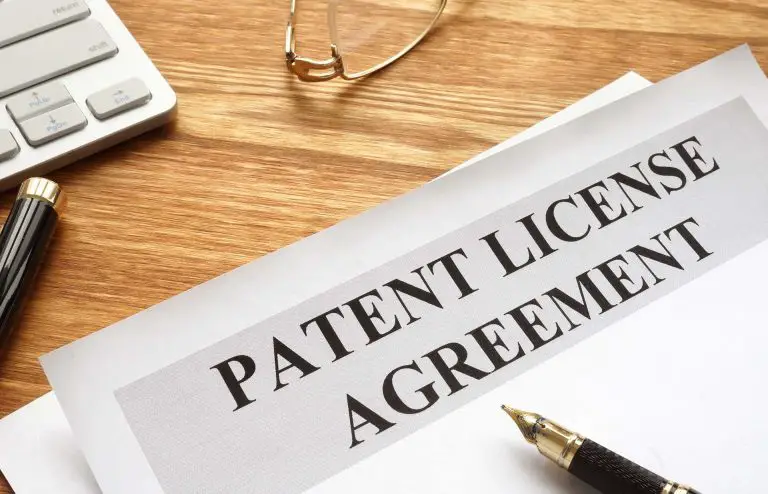
What is a Patent License Agreement?
If you have an invention that you’ve patented, you might be wondering whether you can license your product or invention for others to use? The short answer is that you…
Leave a Reply Cancel reply
You must be logged in to post a comment.

Patent Assignment: A Basic Guide
March 12th, 2020 ‧ 5 min read.

When it comes to patents, many people outside of the industry often make the assumption that the person listed as the inventor on a patent is automatically the owner of that patent as well.
While this is certainly true in some cases, there are several instances when another person or even a company may be assigned ownership of the patent. This is called a “patent assignment,” and it is the subject of today’s article.
Table of contents
Patent assignment: a basic definition, an example of a patent assignment, an additional patent assignment in writing, patent assignments and the uspto, patent assignment database, patent assignment search, is a patent assignment a type of licensing, patent assignment: an important element of the patent ecosystem.
Curious about the patent assignment history? Check out the specific data here !
Basically speaking, a patent assignment is a legal way for an inventor to transfer ownership of a patent to a business.
As you may recall, in the United States, only a person (or group of people) can be listed as the inventor of a patent; a business cannot be listed as the inventor. However, a business can be assigned the ownership of the patent by a person (or group of people).
In this type of agreement, the “assignor” transfers their patent rights to the “assignee.”
It might be helpful to look at an example of a patent assignment. Let’s say an employee of a company comes up with a new invention. This individual employee is the inventor of the product and will be listed on the patent application as such. However, since patents can be very valuable, most companies already have a patent assignment agreement with their employees in place.
This type of agreement would typically state that any type of intellectual property created by an employee of a company while employed by that company would become the property of the company.
Since the company in this example made sure that its employee signed a patent assignment form upon being hired, the invention that the employee came up in the company’s R&D facility will be assigned to the company. The inventor will still be listed in the patent application (and on the patent, if granted) as the inventor.
In addition to the patent assignment agreement mentioned above, it is also recommended that a specific written assignment from the inventor to the company be made whenever a patent application is filed.
If this step is taken, then there will be less trouble if an inventor leaves the company before the patent application has been completed or attempts to contest the patent down the road.
In the United States, patent assignments can be recorded at the USPTO. This can be done at the US patent office’s Assignment Recordation Branch .
Although this can be done online (and without any fees if done electronically) using the Electronic Patent Assignment System (EPAS) , it should be noted that all patent assignment paperwork must be submitted within three months of the patent’s assignment date.
The Patent Assignment Database from USPTO keeps all the patent assignment data records from August 1980 until now. The transfer record will be updated by USPTO, the most recent entry should be the current assignee. However, the system does not check the correctness of the data, specify the current assignee and update timely. It is best to double-check with a third-party database for accuracy.
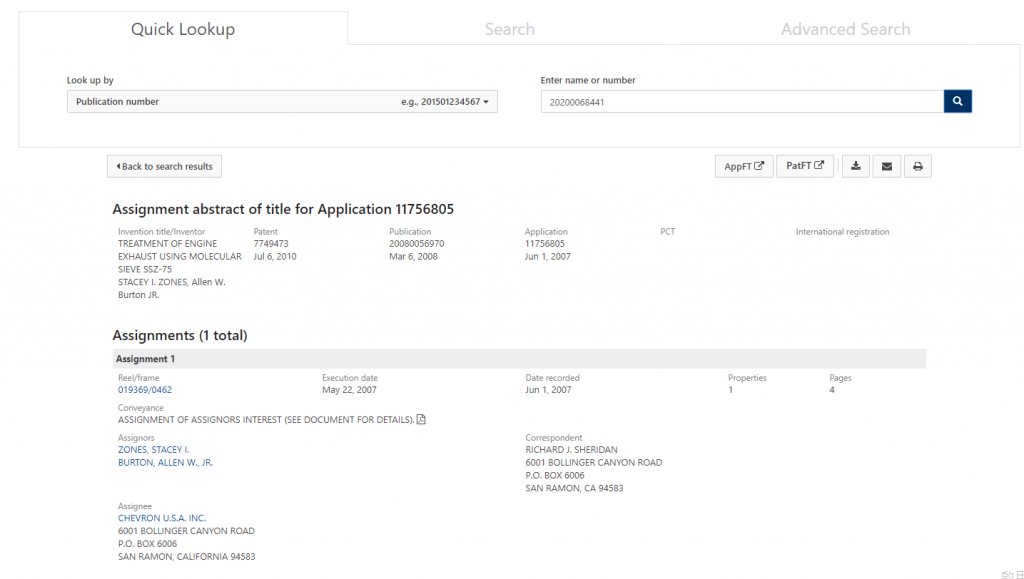
If you need to find out who owns a patent, then you can conduct a patent assignment search. This will tell you who has been assigned a particular patent in the past and who the current assignee is now. The USPTO does offer a free patent assignment search tool on its website, as do other third-party intelligence platforms, such as Patentcloud .
These platforms often feature superior patent assignment databases, with processes that ensure that the assignment data has been cleansed and corrected, meaning more accurate and comprehensive search results.
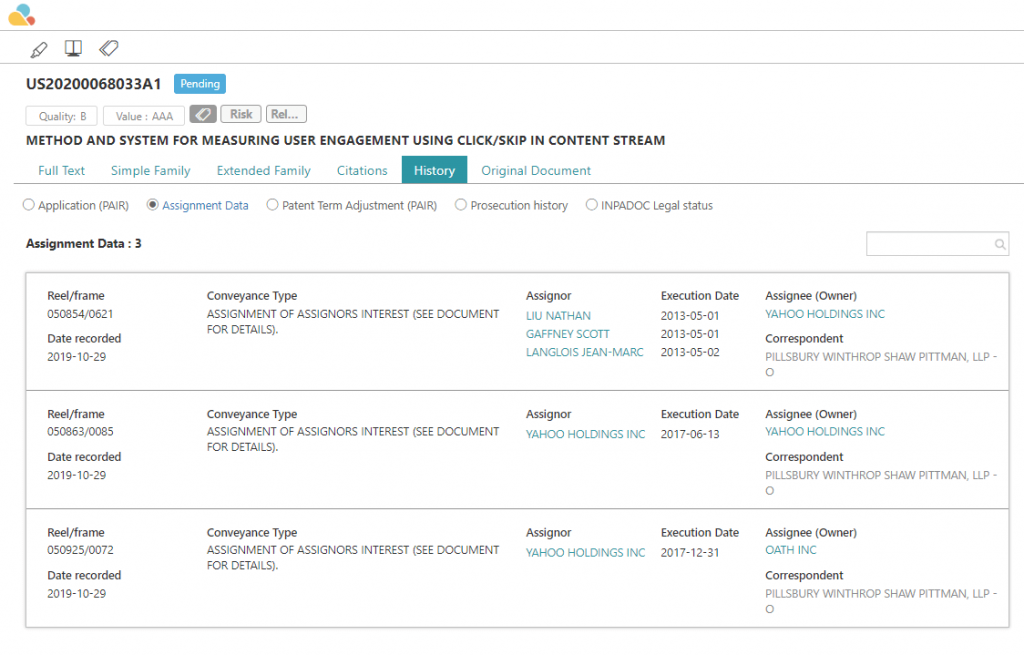
Start your patent assignment search here with Patentcloud’s Patent Search.
Although similar in some ways, these two patent activities are actually quite different.
A licensing agreement means that the owner of the patent (or “licensor”) gives another person or company (the “licensee”) the right to use the patented technology for an agreed-upon period of time. However, the licensor remains the owner of the patent.
A patent assignment, on the other hand, involves a complete and permanent transfer (or “assignment”) of ownership of a patent from the owner (or “assignor”) to another party (the “assignee”). Put simply, patent assignment involves “ownership” while patent licensing involves “permission to use.”
Assignment data analysis can provide actionable insights for those operating in the transaction market and IP stakeholders alike, enabling them to:
- Anticipate the future strategy of a company: the acquisition of patents covering a specific technology could well be an indicator of the company’s future plans and strategies;
- Anticipate the developments of an industry: multiple companies — especially larger ones — acquiring patents in a certain technology field could also prove to be an indicator of the imminent popularity of a technology field.
The acquisition of Oculus VR by Facebook is a perfect example of this: in 2014, Facebook bought the VR company for around $2 billion. In the deal, Facebook also acquired all of the patents. Facebook’s focus on VR was a significant moment: today, VR technology is one of the most active patent-wise. This activity is not just limited to the gaming sector, the following industries have also experienced increased activity:
- Data visualization;
- The treatment of mental illnesses.
The acquisition by Facebook proved to be a clear signal that:
- Facebook was likely to invest heavily in the development of VR technologies;
- The VR industry was going to be popular in the near future.
There you have it. Though often overlooked and even misunderstood, patent assignments are actually a very important element of the patent ecosystem. With a better understanding of patent assignments, you can gain valuable insights into industry trends and even the business strategies of specific companies. You can also gain a better understanding of a company’s own R&D capabilities.
Share This Information.
Related posts.
Patent Assignment: The Importance of Current Patent Assignee Accuracy
Essential Takeaways from 2020’s Q1 US Patent Assignment Data
Patent Assignment Data: 8 Essential Takeaways from 2019 Q4 US Patent Market
An Inventor’s Guide to Understanding Prior Art
The IP world moves fast
Subscribe to receive the latest insights right in your inbox.
By submitting your contact information, you understand and agree to our GDPR , Terms of Use and Privacy Policy
Get started with Patentcloud today
Discover how Patentcloud’s solutions and tools can work for you.
InQuartik Corporation, as the administrator of this website, uses browser cookies to track your session to provide you with a better experience.
You may opt out of all cookies that are not essential to the administration or maintenance of this website.
You may refer to our Privacy and Cookie Policy for more details. Please note that, by accessing our website, you agree to our Privacy and Cookie Policy.

Privacy Overview

An official website of the United States government
Here’s how you know
Official websites use .gov A .gov website belongs to an official government organization in the United States.
Secure .gov websites use HTTPS A lock ( Lock A locked padlock ) or https:// means you’ve safely connected to the .gov website. Share sensitive information only on official, secure websites.
https://www.nist.gov/iedison/iedison-organization-user-guide/patent-reports/submitting-patent-assignment-request
Submitting a Patent Assignment Request
Things to know before submitting a patent assignment request.
A Patent Assignment Request should be submitted when you are seeking agency permission to assign your rights to an individual patent to either an inventor or another third party. If you are wishing to retain your ownership of the patent, but simply have another joint owner (who also has federal funding), take the lead in iEdison reporting, then you should submit a Patent Transfer Request.
Be sure to communicate and coordinate with the inventor/third party to whom you wish to assign the patent as they will be required to register in iEdison (if they do not already have an account) and accept receipt of the patent in iEdison prior to agency review of the Patent Assignment Request.
Please resolve all notifications possible under the Patent Report prior to submitting the Patent Assignment Request.
NOTE: Supporting Documentation is required in order to submit this request. The type of Supporting Documentation is determined by the Federal Funding Agency. Contact your funding agency if you do not have a copy of the form/documentation they require in order to process a Patent Assignment Request.
To submit a Patent Assignment Request, complete the following steps:
- Click the "Add Request" button on the Patent Report
- Select "Assignment" and enter the required information
Click "Save"
1. Click the "Add Request" button on the Patent Report
Under the Requests section of the Patent Report, click the "Add Request" button.
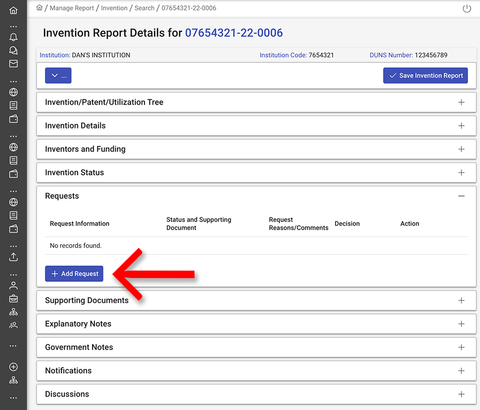
2. Select "Assignment" and enter the required information
After clicking the "Add Request" button, a popup window will open requiring you to select the request type and enter additional information (depending on the request).
Select "Assignment" from the pulldown menu. A field will appear requiring you to choose to assign the patent to either Inventor(s) or Third Party.
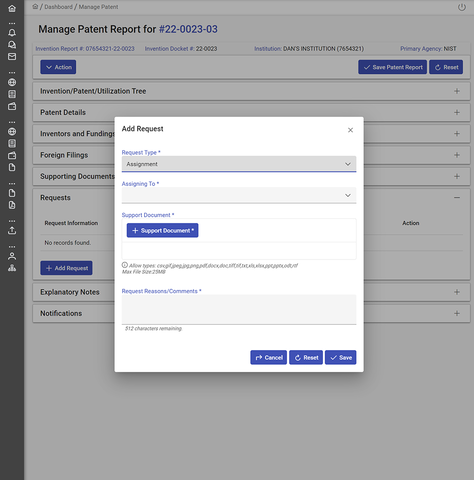
If you select Inventor(s), two additional fields will appear requiring you to enter the Inventor Name and Inventor's Organization Code. The information will auto-populate as you type in these fields. You may enter the name of the Organization if you do not know the Organization Code.
If you select Third Party, two additional fields will appear asking for a Third Party Name and Third Party's Organization Code. Only the Organization code is required. The information will auto-populate as you type.
Whether you're assigning to an Inventor or an Organization, you must upload the Support Document required by your funding agency. Click the "Support Document" button to locate the file on your local computer. You may also drag and drop a file into this popup window.
In the "Request Reasons/Comments" field, you're required to briefly explain the reason for the Assignment Request.
Click the "Save" button on the popup window.
The recipient Organization will then receive a notification to accept the assignment (for information on how a recipient Organization accepts/rejects an assignment see Receiving a Patent Assignment, Patent Transfer , or Patent Void Request . If they accept the assignment, a notification will be sent to the Primary Funding Agency notifying them of the Patent Assignment Request. If the recipient Organization rejects the assignment, the Patent Assignment Request will not be sent to the Funding Agency for review.
While the Funding Agency's decision is pending, you may click the "Edit" button to make changes, or if you feel the request was made in error, you may click the "Withdraw" button. If you wish to check on the status of the request, you may click the "Agency Decision" button to view an update.
If approved, you will receive a notification indicating the approval, and the Patent Report will be assigned to the recipient Organization. You will no longer have access to the active Patent Report, however, the assigned Patent Report will be searchable/viewable as a transferred/assigned record.
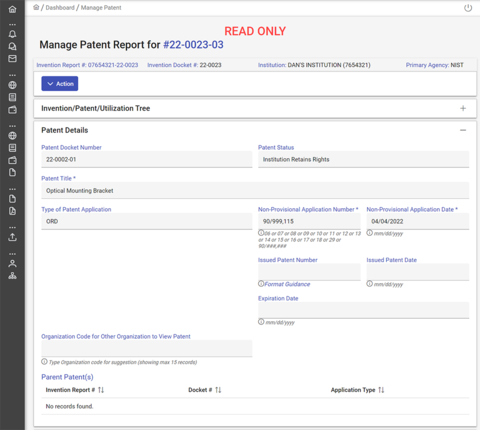
If for some reason the request is rejected, you will receive a notification indicating the rejection. The Decision and the Rejection Reasons will be displayed next to the Request in the Patent Report.
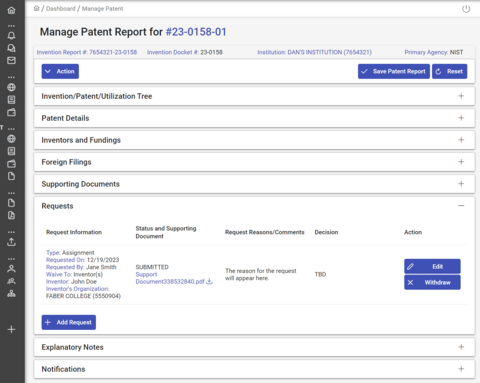
This patent assignment is between , an individual a(n) (the " Assignor ") and , an individual a(n) (the " Assignee ").
The Assignor has full right and title to the patents and patent applications listed in Exhibit A (collectively, the " Patents ").
The Assignor wishes to transfer to the Assignee, and the Assignee wishes to purchase and receive from the Assignor, all of its interest in the Patents.
The parties therefore agree as follows:
1. ASSIGNMENT OF PATENTS.
The Assignor assigns to the Assignee, and the Assignee accepts the assignment of, all of the Assignor's interest in the following in the United States and its territories and throughout the world:
- (a) the Patents listed in Exhibit A ;
- (b) the patent claims, all rights to prepare derivative works, goodwill, and other rights to the Patents;
- (c) all registrations, applications (including any divisions, continuations, continuations-in-part, and reissues of those applications), corresponding domestic and foreign applications, letters patents, or similar legal protections issuing on the Patents, and all rights and benefits under any applicable treaty or convention;
- (d) all income, royalties, and damages payable to the Assignor with respect to the Patents, including damages and payments for past or future infringements of the Patents; and
- (e) all rights to sue for past, present, and future infringements of the Patents.
2. CONSIDERATION.
The Assignee shall pay the Assignor a flat fee of as full payment for all rights granted under this agreement. The Assignee shall complete this payment no later than .
3. RECORDATION.
In order to record this assignment with the United States Patent and Trademark Office and foreign patent offices, within hours of the effective date of this assignment, the parties shall sign the form of patent assignment agreement attached as Exhibit B . The Assignor Assignee is solely responsible for filing the assignment and paying any associated fees of the transfer.
4. NO EARLY ASSIGNMENT.
The Assignee shall not assign or otherwise encumber its interest in the Patents or any associated registrations until it has paid to the Assignor the full consideration provided for in this assignment. Any assignment or encumbrance contrary to this provision shall be void.
5. ASSISTANCE.
- (1) sign any additional papers, including any separate assignments of the Patents, necessary to record the assignment in the United States;
- (2) do all other lawful acts reasonable and necessary to record the assignment in the United States; and
- (3) sign all lawful papers necessary for Assignee to retain a patent on the Patents or on any continuing or reissue applications of those Patents.
- (b) Agency. If for any reason the Assignee is unable to obtain the assistance of the Assignor, the Assignor hereby appoints the Assignee as the Assignor's agent to act on behalf of the Assignor to take any of the steps listed in subsection (a).
6. NO LICENSE.
After the effective date of this agreement, the Assignor shall make no further use of the Patents or any patent equivalent, except as authorized by the prior written consent of the Assignee. The Assignor shall not challenge the Assignee's use or ownership, or the validity, of the Patents.
7. ASSIGNOR'S REPRESENTATIONS.
The Assignor hereby represents to the Assignee that it:
- (a) is the sole owner of all interest in the Patents;
- (b) has not transferred, exclusively licensed, or encumbered the Patents or agreed to do so;
- (c) is not aware of any violation or infringement of any third party's rights (or a claim of a violation or infringement) by the Patents;
- (d) is not aware of any third-party consents, assignments, or licenses that are necessary to perform under this assignment;
- (e) was not acting within the scope of employment of any third party when conceiving, creating, or otherwise performing any activity with respect to the Patents.
The Assignor shall immediately notify the Assignee in writing if any facts or circumstances arise that would make any of the representations in this assignment inaccurate.
8. INDEMNIFICATION.
The Assignor shall indemnify the Assignee against:
- (a) any claim by a third party that the Patents or their creation, use, exploitation, assignment, importation, or sale infringes on any patent or other intellectual property;
- (b) any claim by a third party that this assignment conflicts with, violates, or breaches any contract, assignment, license, sublicense, security interest, encumbrance, or other obligation to which the Assignor is a party or of which it has knowledge;
- (c) any claim relating to any past, present, or future use, licensing, sublicensing, distribution, marketing, disclosure, or commercialization of any of the Patents by the Assignor; and
- (d) any litigation, arbitration, judgments, awards, attorneys' fees, liabilities, settlements, damages, losses, and expenses relating to or arising from (a), (b), or (c) above.
- (i) the Assignee promptly notifies the Assignor of that claim;
- (ii) the Assignor controls the defense and settlement of that claim;
- (iii) the Assignee fully cooperates with the Assignor in connection with its defense and settlement of that claim;
- (iv) the Assignee stops all creation, public use, exploitation, importation, distribution, or sales of or relating to the infringing Patents, if requested by the Assignor.
- (i) obtain the right for the Assignee to continue to use the infringing Patent;
- (ii) modify the infringing Patent to eliminate the infringement;
- (iii) provide a substitute noninfringing patent to the Assignee pursuant to this assignment; or
- (iv) refund to the Assignee the amount paid under this assignment for the infringing Patent.
- (c) No Other Obligations. The Assignor shall have no other obligations or liability if infringement occurs, and shall have no other obligation of indemnification or to defend relating to infringement. The Assignor shall not be liable for any costs or expenses incurred without its prior written authorization and shall have no obligation of indemnification or any liability if the infringement is based on (i) any modified form of the Patents not made by the Assignor, (ii) any finding or ruling after the effective date of this assignment, or (iii) the laws of any country other than the United States of America or its states.
9. GOVERNING LAW.
- (a) Choice of Law. The laws of the state of govern this agreement (without giving effect to its conflicts of law principles).
- (b) Choice of Forum. Both parties consent to the personal jurisdiction of the state and federal courts in County, .
10. AMENDMENTS.
No amendment to this assignment will be effective unless it is in writing and signed by a party or its authorized representative.
11. ASSIGNMENT AND DELEGATION.
- (a) No Assignment. Neither party may assign any of its rights under this assignment, except with the prior written consent of the other party. All voluntary assignments of rights are limited by this subsection.
- (b) No Delegation. Neither party may delegate any performance under this assignment, except with the prior written consent of the other party.
- (c) Enforceability of an Assignment or Delegation. If a purported assignment or purported delegation is made in violation of this section, it is void.
12. COUNTERPARTS; ELECTRONIC SIGNATURES.
- (a) Counterparts. The parties may execute this assignment in any number of counterparts, each of which is an original but all of which constitute one and the same instrument.
- (b) Electronic Signatures. This assignment, agreements ancillary to this assignment, and related documents entered into in connection with this assignment are signed when a party's signature is delivered by facsimile, email, or other electronic medium. These signatures must be treated in all respects as having the same force and effect as original signatures.
13. SEVERABILITY.
If any one or more of the provisions contained in this assignment is, for any reason, held to be invalid, illegal, or unenforceable in any respect, that invalidity, illegality, or unenforceability will not affect any other provisions of this assignment, but this assignment will be construed as if those invalid, illegal, or unenforceable provisions had never been contained in it, unless the deletion of those provisions would result in such a material change so as to cause completion of the transactions contemplated by this assignment to be unreasonable.
14. NOTICES.
- (a) Writing; Permitted Delivery Methods. Each party giving or making any notice, request, demand, or other communication required or permitted by this assignment shall give that notice in writing and use one of the following types of delivery, each of which is a writing for purposes of this assignment: personal delivery, mail (registered or certified mail, postage prepaid, return-receipt requested), nationally recognized overnight courier (fees prepaid), facsimile, or email.
- (b) Addresses. A party shall address notices under this section to a party at the following addresses:
- If to the Assignor:
- If to the Assignee:
- (c) Effectiveness. A notice is effective only if the party giving notice complies with subsections (a) and (b) and if the recipient receives the notice.
15. WAIVER.
No waiver of a breach, failure of any condition, or any right or remedy contained in or granted by the provisions of this assignment will be effective unless it is in writing and signed by the party waiving the breach, failure, right, or remedy. No waiver of any breach, failure, right, or remedy will be deemed a waiver of any other breach, failure, right, or remedy, whether or not similar, and no waiver will constitute a continuing waiver, unless the writing so specifies.
16. ENTIRE AGREEMENT.
This assignment constitutes the final agreement of the parties. It is the complete and exclusive expression of the parties' agreement about the subject matter of this assignment. All prior and contemporaneous communications, negotiations, and agreements between the parties relating to the subject matter of this assignment are expressly merged into and superseded by this assignment. The provisions of this assignment may not be explained, supplemented, or qualified by evidence of trade usage or a prior course of dealings. Neither party was induced to enter this assignment by, and neither party is relying on, any statement, representation, warranty, or agreement of the other party except those set forth expressly in this assignment. Except as set forth expressly in this assignment, there are no conditions precedent to this assignment's effectiveness.
17. HEADINGS.
The descriptive headings of the sections and subsections of this assignment are for convenience only, and do not affect this assignment's construction or interpretation.
18. EFFECTIVENESS.
This assignment will become effective when all parties have signed it. The date this assignment is signed by the last party to sign it (as indicated by the date associated with that party's signature) will be deemed the date of this assignment.
19. NECESSARY ACTS; FURTHER ASSURANCES.
Each party shall use all reasonable efforts to take, or cause to be taken, all actions necessary or desirable to consummate and make effective the transactions this assignment contemplates or to evidence or carry out the intent and purposes of this assignment.
[SIGNATURE PAGE FOLLOWS]
Each party is signing this agreement on the date stated opposite that party's signature.
[PAGE BREAK HERE]
EXHIBIT A PATENTS AND APPLICATIONS
FORM OF RECORDABLE PATENT APPLICATION ASSIGNMENT
For good and valuable consideration, the receipt of which is hereby acknowledged, between , an individual a(n) (the " Assignor ") and , an individual a(n) (the " Assignee ") all of the Assignor's interest in the Assigned Patents identified in Attachment A to this assignment, and the Assignee accepts this assignment.
Each party is signing this agreement on the date stated opposite that party's signature.
ATTACHMENT A ASSIGNED PATENTS
Free Patent Assignment Template
Simplify the process of transferring patent rights for both buyers and sellers with a patent assignment agreement. document the ownership transfer clearly and efficiently..
Complete your document with ease
How-to guides, articles, and any other content appearing on this page are for informational purposes only, do not constitute legal advice, and are no substitute for the advice of an attorney.
Patent assignment: How-to guide
A company’s ability to buy and sell property is essential for its long-term life and vitality. Although it doesn’t take up physical space, too much intellectual property can burden a company, directing limited funds towards maintaining registrations, defending against third-party claims, or creating and marketing a final product.
Selling unused or surplus intellectual property can have an immediate positive effect on a company’s finances, generating revenue and decreasing costs. When it does come time to grow a business, companies looking to purchase property (including patents and other inventions) to support their growth must be sure that the seller does have title to the desired items. A properly drafted patent assignment can help in these circumstances.
A patent assignment is the transfer of an owner’s property rights in a given patent or patents and any patent applications. These transfers may occur independently or as part of larger asset sales or purchases. Patent assignment agreements provide both records of ownership and transfer and protect the rights of all parties.
This agreement is a written acknowledgment of the rights and responsibilities being transferred as part of your sale. This will provide essential documentation of ownership and liability obligations, and you will be well on your way to establishing a clear record of title for all of your patents.
Important points to consider while drafting patent assignments
What is a patent.
A patent is a set of exclusive rights on an invention given by the government to the inventor for a limited period. Essentially, in exchange for the inventor’s agreement to make their invention public and allow others to examine and build on it, the government provides the inventor with a short-term monopoly on their creation. In other words, only they can make, use, or sell that invention.
Are licenses and assignments different from each other?
Licenses are different from assignments. The individual who receives license rights from the patent holder isn’t gaining ownership. Rather, they’re getting assurance from the patent holder that they won’t be sued for making, using, or selling the invention. The terms of the license will vary from agreement to agreement and may address issues of royalties, production, or reversion.
What are the different kinds of patent assignments?
A patent assignment can take many forms.
- It can be the transfer of an individual’s entire interest to another individual or company.
- It can also transfer a specific part of that interest (e.g., half interest, quarter interest, etc.) or a transfer valid only in a designated country area. The exact form of the transfer is specific to the parties' agreement.
What is the role of the United States Patent and Trademark Office in patent transfer?
A patent transfer is usually accomplished through a contract, like the following written agreement form. However, after the parties have negotiated and signed their agreement, the transfer must be recorded with the U.S. Patent and Trademark Office (USPTO) . The agreement will only be effective if this registration is made. Moreover, if the transfer isn’t recorded within three months from the date of the assignment, there can be no later purchasers. In other words, such patents are no longer sellable to a third party by the assignee if it isn’t recorded quickly and correctly.
Note that there is a fee for recording each assignment of a patent or patent application.
What details should I add to my patent application?
Although you can adapt the document to suit your arrangement, you should always identify the patent(s) being assigned by their USPTO number and date and include the name of the inventor and the invention’s title (as stated in the patent itself). This is a requirement of federal law, and failure to follow it could invalidate your assignment.
What are the benefits of patent assignment?
The advantage of selling your invention or patent outright (and not simply licensing or attempting to develop and market it yourself) is that you’re guaranteed payment at the price you and the purchaser have negotiated.
On the other hand, that one-time payment is all that you will ever receive for your property. You will no longer have the right to control anyone else’s use of your creation.
By using it yourself or offering a temporary license, you retain the potential for future income. However, such income isn’t certain, and your opportunities are paralleled by risk.
Before selling all of your rights in a patent or patent application, ensure this is the best (and most lucrative) approach for you and your company.
Is it necessary to do due diligence before buying a patent?
Provide valuable consideration to due diligence, and don’t agree without completing it. If you purchase a patent, conduct searches with the patent office on the patents issued and online directories to ensure the seller has complete and unique rights in the offered property. Look for these:
- Has an application already been filed by another person or company?
- What are the chances that this is a patentable item?
Although your findings won’t be guaranteed, you may be protected as an “innocent purchaser” if disputes arise.
You might also find critical information about the value of the patent. Consider hiring a patent attorney to help in your investigation. Comparing patents and applications often requires a specialized and technical understanding to know how useful and unique each one is.
What should I consider while selling a patent?
If you sell an invention or patent, ensure you own it. Although this may seem obvious, intellectual property ownership sometimes must be clarified. This may be the case if, for example, the invention was created as part of your employment or if it was sold or otherwise transferred to somebody else. A thorough search of the USPTO website for the publication number should be conducted before you attempt to sell your property.
Is reviewing and signing the patent necessary?
Review the assignment carefully to ensure all relevant deal points are included. Don't assume certain terms are agreed upon if not stated in the document.
Once the document is ready, sign two copies of the assignment, one for you and one for the other party.
Get the assignment notarized by the notary public to reduce the challenges to the validity of a party’s signature or the transfer itself.
If you’re dealing with a complex agreement for a patent assignment , contact an attorney to help draft an assignment that meets your needs.
Key components to include in patent assignments
The following provisions will help you understand the terms of your assignment. Please review the entire document before starting your step-by-step process.
Introduction of parties
This section identifies the document as a patent assignment. Add the assignment effective date, parties involved, and what type of organization(s) they are. The “assignor” is the party giving their ownership interest, and the “assignee” is the party receiving it.
The “whereas” clauses, or recitals, define the world of the assignment and offer key background information about the parties. In this agreement, the recitals include a simple statement of the intent to transfer rights in the patent. Remember that the assignor can transfer all or part of its interest in the patents.
Assignment of patents
This section constitutes the assignment and acceptance of patents and inventions. Be as complete and clear as possible in your description of the property being transferred.
Consideration
In most agreements, each party is expected to do something. This obligation may be to perform a service, transfer ownership of property, or pay money. In this case, the assignee gives money (sometimes called “consideration”) to receive the assignor’s property. Enter the amount to be paid, and indicate how long the assignee has to make that payment after the agreement is signed.
Authorization to a director
This section is the assignor’s authorization to issue patents in the assignee’s name. In other words, this tells the head of the patent and trademark office that the transfer is valid and that ownership is changing hands by the assignment.
If the assignment is being recorded after the USPTO has issued a patent number, add the patent application number here.
Assignor’s representations and warranties
In this section, the assignor is agreeing to the following terms:
- They’re the sole owner of the inventions and the patents. If there are other owners who aren’t transferring their interests, this means that the only part being transferred is the assignor’s part.
- They haven’t sold or transferred the inventions and the patents to any third party.
- They have the authority to enter the agreement.
- They don’t believe that the inventions and the patents have been taken from any third party without authorization (e.g., a knowing copy of another company’s invention).
- They don’t know if any permissions must be obtained for the assignment to be completed. In other words, once the agreement is signed, the assignment will be effective without anyone else’s input.
- The patents weren’t created while a third party employed the creator. In many cases, if a company employs an individual and comes up with a product, the company will own that product. This section offers assurance to the assignee that there are no companies that will make that claim about the patents being sold.
If you and the other party want to include additional representations and warranties, you can do so here.
Assignee’s representations and warranties
In this section, the assignee is agreeing to the following terms:
- They have the authority to enter into the agreement
- They have enough funds to pay for the assignment
No early assignment
This section prevents the assignee from re-transferring the inventions or patents or using any of them as collateral for loans until it has completely paid the money due under the agreement.
Documentation
This clause is the assignor’s promise to help with any paperwork needed to complete an assignment, such as filing information about the assignment with the USPTO, transferring document titles, transferring paperwork for filing to foreign countries, etc.
No further use of inventions or patents
This section indicates that after the agreement’s filing date, the assignor will stop using all the inventions and patents being transferred and won’t challenge the assignee’s use of those inventions or patents.
Indemnification
This clause describes each party’s future obligations if the patent or any application is found to infringe on a third party’s rights. Either the assignor agrees to take all responsibility for infringement, promising to pay all expenses and costs relating to the claim, or the assignor makes its responsibilities conditional, significantly limiting its obligations if a claim is brought.
Successors and assigns
This section states that the parties’ rights and obligations will be passed on to successor organizations (if any) or organizations to which rights and obligations have been permissibly assigned.
No implied waiver
This clause explains that even if one party allows the other to ignore or break an obligation under the agreement, it doesn’t mean that the party waives any future rights to require the other to fulfill those (or any other) obligations.
Provide the assignor and assignee’s address where all the official or legal correspondence should be delivered.
Governing law
This provision lets the parties choose the state laws used to interpret the document.
Counterparts; electronic signatures
This section explains that if the parties sign the agreement in different locations, physically or electronically, all the separate pieces will be considered part of the same agreement.
Severability
This clause protects the terms of the agreement as a whole, even if one part is later invalidated. For example, if a state law is passed prohibiting choice-of-law clauses, it won’t undo the entire agreement. Instead, only the section dealing with the choice of law would be invalidated, leaving the remainder of the assignment enforceable.
Entire agreement
This section indicates the parties’ agreement that the document they’re signing is “the agreement” about transferring the issued patent.
This clarifies that the headings at the beginning of each section are meant to organize the document and shouldn’t be considered operational parts of the note .
Frequently asked questions
What is a patent assignment .
If you want to buy patents, the first step is to ensure the seller (original owner) owns the patent rights. The second step is the transfer of the patent owner's rights to the buyer. Patent assignments are agreements that cover both steps, helping the buyer and the seller with ownership records and quickly enabling transfer.
What are the requirements for patent assignment?
Here's the information you'll require to complete a patent assignment:
- Who the assignor is : Have their name and contact information ready
- Who the assignee is : Have their information available
- Invention info : Know the inventor's name, invention's registration number, and filing date
Related templates

Assignment of Agreement
Transfer work responsibilities efficiently with an assignment of agreement. Facilitate a smooth transition from one party to another.

Copyright Assignment
Protect your intellectual property with a copyright assignment form. Securely transfer your copyright to another party, clearly defining ownership terms while preserving your rights effectively.

Intellectual Property Assignment Agreement
Safeguard the sale or purchase of assets with an intellectual property assignment agreement. Transfer the ownership of patents, trademarks, software, and other critical assets easily.

Patent Application Assignment
Transfer the ownership rights or interests in a patent application. A patent application agreement defines the terms of transfer, promotes collaboration, and mitigates risks.

Trademark Assignment
Simplify the buying and selling of trademarks with a trademark assignment agreement. Transfer intellectual property rights and ensure a fair and smooth transaction.

Trademark License Agreement
Ensure fair use of intellectual property with a trademark license agreement. Outline the terms of usage and compensation.
- Select location
- United Kingdom
- United States
Federal Circuit Reversal in Assignment Clause Case Highlights Importance of Contract Language in Intellectual Property Ownership
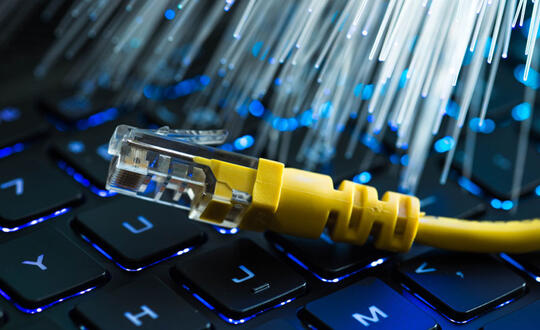
Contributors

Jeffrey S. Whittle

Karthika Perumal, Ph.D.

Samuel A. Savanich
In a split opinion issued Tuesday , and based on language in an assignment clause of a contract, the Federal Circuit overturned a district court's summary judgment that Core Optical lacked standing to sue Nokia, Cisco, and ADVA for infringement.
The case, involving a fiber optic patent, centers on the interpretation of the phrase "entirely on my own time" within an assignment clause of the inventor's contractual agreement with his former employer, TRW Inc.
Nokia, Cisco, and ADVA contended that Dr. Mark Core's assignment of his patent rights to Core Optical was invalid because these rights allegedly had been automatically assigned to Dr. Core's employer, TRW, at the time of the invention. The inventor's contract with TRW stipulated that any inventions developed during work hours were to be assigned to the company, while inventions developed entirely on his “own time” remained Dr. Core’s property.
Initially, the lower court granted Nokia and the defendants summary judgment, ruling that the invention was developed as part of the Dr. Core’s research, funded by TRW, and was at least in part “TRW time” and not “entirely” Dr. Core’s “own time.” Therefore, this court concluded that the patent was automatically assigned to TRW, and Core Optical, Dr. Core’s company, lacked standing to sue.
The Federal Circuit majority, however, decided on appeal that it was not clear if the Ph.D. research conducted by Dr. Core constituted the inventor's own time. On one hand, Dr. Core was free to use particular hours or days for his research with no accountability to TRW; and, on the other hand, he worked on projects connected to TRW’s business on TRW-funded fellowship, with reporting obligations to TRW. Therefore, the Federal Circuit vacated the judgment and remanded the case back to the district court for further proceedings, thereby allowing Dr. Core to proceed with his patent infringement lawsuit.
The majority opinion noted, “[b]oth Core Optical’s and Nokia's interpretations of how the years-long, TRW-funded research should be treated under the 1990 invention agreement are plausible based on the undisputed facts presented. However, which interpretation prevails has not been determined, acknowledging that the contract language does not have an unambiguous meaning when applied to these facts.”
In dissent, U.S. Circuit Court Judge Haldane Robert Mayer argued that the lower court was correct in ruling that the inventor did not develop the fiber optic patent on his own time.
This majority decision underscores the complexities and nuances surrounding intellectual property rights and the importance of clear contractual terms regarding intellectual property issues, especially for intellectual property developed by an individual during non-traditional employment, such as employees permitted to pursue research or consulting projects. Care should be taken when drafting assignment and other intellectual property related language to reduce risk of a finding of ambiguity as in this instance.
Womble Bond Dickinson Newsletter
Sign up to receive fresh content delivered to your inbox weekly!
Recommended
How are the uspto’s proposed rule changes for terminal disclaimers problematic: let me count the ways, doj announces new task force on health care monopolies and collusion, ftc claims against pe firm put to sleep, enhancing trade-based money laundering detection: retrieval-augmented generation and semantic search technologies, supreme court rules copyright claims timeless with timely filing, irs publishes final regulations for transfer of certain credits, what to expect from the select committee on the chinese communist party under the leadership of chairman moolenaar, dea accepts hhs recommendation to reschedule cannabis, doj enhancing its sanctions toolkit, ftc issues new rule—but not the final chapter—on non-competes: what employers need to know, criminal division of u.s. department of justice announces pilot program on voluntary self-disclosure for individuals.
You are switching to the United States
This selection will switch the website from presenting information primarily about the United Kingdom to information about the United States . If you would like to switch back, you may use location selection options at the top of the page.
Although we would like to hear from you, we cannot represent you until we know that doing so will not create a conflict of interest. Also, we cannot treat unsolicited information as confidential. Accordingly, please do not send us any information about any legal matter until we authorize you to do so. To initiate a possible representation, please call one of our lawyers or staff members.
By clicking the “ACCEPT” button, you agree that we may review any information you transmit to us. You recognize that, even if you submit information that you consider confidential in an effort to retain us, our review of that information will not create an obligation on us to keep it confidential and will not preclude us from representing another client directly adverse to you, even in a matter where that information could and will be used against you.
Please click the “ACCEPT” button if you understand and accept the foregoing statement and wish to proceed.
{% trans "Vous utilisez un navigateur obsolète. Mettez à jour votre navigateur pour une utilisation optimale de ce site" %}
News ([[posts.total]])
Lawyers ([[lawyers.total]])
Events ([[events.total]])
Practice Areas ([[knowledges.total]])
Challenges ([[challenges.total]])
- In-Focus ([[zoomons.total]])
Challenges ([[zoomons.total]])
Sony Court of Cassation ruling of April 24, 2024: admissibility of infringement claims even for events occurring prior to registration of the assignment.
Article Patent Law | 22/05/24 | 8 min. | Grégoire Desrousseaux Geoffrey Grandjean Océane Millon de La Verteville
Registration of the assignment in the National Patent Register (NPR) enables the assignee of a patent to enforce the assigned patent against third parties in an infringement action. However, one question was still widely debated: once the registration has taken place, which acts of infringement can the assignee obtain compensation for? Only those committed after the registration? Or also those committed between the date of the assignment and the date of registration? Or even those committed before the date of the assignment? In a ruling dated April 24, 2024 (appeal no. 22-22.999 ) , the French Supreme Court (Cour de cassation) opted for the broadest answer, no doubt prompted by the CJEU's 2016 rulings in Hassan and Phillipscases – which relate to trademarks and register designs - that a licensee may bring proceedings alleging infringement of the intellectual property which is the subject of the licence, although that licence has not been entered in the register [1] .
This ruling of the Supreme Court has been taken in appeal of a decision by the Paris Court of Appeal on 9 September 2022, in a dispute between some companies part of the Sony group, in particular the Japanese company Sony Interactive Entertainment Inc. ("Sony JP"), owner of the patents at stake, and the French company Subsonic.
The origin: the classic situation of patents assigned as part of a universal transfer of intra-group assets which included intellectual property rights, but not registered at the date when the infringement case was launched.
The defendant argued that Sony JP lacked standing to sue, on the grounds that (i) it had not provided proof of the universal transfer of assets by which it claimed to have been assigned the patents in 2010, and (ii) that in any event, the intra-group transfer alleged to have taken place as part of this universal transfer was not registered in the National Patent Register (NPR) until after the summons, and therefore the patents were unenforceable at the date when the infringement case was launched , and Sony JP was therefore inadmissible for all facts occurring prior to the registration.
This argument enabled Subsonic to dismiss all Sony’s infringement claims, since in this case, all the alleged infringing acts predated the registration of the assignment.
At first instance, the court ruled that Sony JP was inadmissible on the first ground: it had not provided proof that it was the owner of the patents [2] .
On appeal, Sony JP produced new documents, on the basis of which the court found that, contrary to the lower court, the proof of the 2010 universal transfer of assets had indeed been provided [3] . On the other hand, noting that the transfer had been registered in the NPR 18 months after the introduction of the action, the court followed the defendant's argument, holding that Sony JP was not, at the date the infringement case was launched , the owner of an IP right enforceable against third parties and was therefore not, at that date, entitled to bring an infringement action. The Court of Appeal also considered that "if, as provided for in article 126 of the French Code of Civil Procedure, a plea of inadmissibility can be regularized in the course of proceedings, such regularization can only have effect in respect of acts committed subsequent to the registration made". Sony was therefore declared inadmissible to bring an infringement action for all acts committed prior to registration, i.e. for all acts alleged to be infringing in this case.
Referring to articles L.613-9 first paragraph, and L.615-2 first paragraph, of the French Intellectual Property Code and article 126 of the French Civil Procedure Code (CPC), the Supreme Court begins by reiterating the now well-established principle that, as long as the transfer has not been registered in the NPR, the successor in title (in this case, the assignee) cannot invoke the patent rights arising from the date of the contract which transferred ownership of the patent to him, and is therefore not entitled to bring an infringement action [4] . This reaffirms the importance of registration as a precondition for action.
However, the French Supreme Court then overturned the reasoning of the Court of Appeal, which considered that from the date of registration in the NPR, the assignee was only entitled to sue for infringement committed after registration.
The French Suprem Court has ruled that, from the date of registration, the assignee is entitled to bring an infringement action for compensation (i) for the damage caused to him by acts committed since the transfer, and (ii) if the deed transferring the rights so specifies, for the damage caused to him by acts committed prior to the transfer.
It is not surprising that the assignee can act against acts committed prior to the transfer if the deed of assignment of the patent provides for an assignment of the right to act for facts prior to the assignment, in this case the assignee is subrogated to the assignor's right to act.
On the other hand, it is more surprising that in the case of a registration made during the course of the proceedings (regularization hypothesis), the assignee is entitled to take action not only against acts committed since the registration, but also against acts committed between the date of the transfer and such registration.
In conclusion, this decision is very favorable to assignees who may have delayed registering the assignment. Nevertheless, it would seem sensible to encourage any assignee (i) to include in the assignment deed the possibility for the assignee to bring an infringement action for facts predating the assignment, and (ii) to register the deed in the NPR as soon as possible. Firstly, one does not yet know how judges will react to the Supreme Court decision. Secondly, registration is still required to request a seizure [5] (“saisie-contrefaçon”) and, as the seizure procedure is distinct from the proceedings on the merits, if the regularization takes place during the proceedings on the merits, it is only valid for the latter and not for the previous seizure procedure, which has been closed since the decision which allowed the seizure. Lastly, counterfeiters could argue, by analogy with the foreclosure referred to in paragraph 2 of article 126 of the CPC, that only the registration in the RNB (and not the summons) interrupts the statute of limitations.
[1] CJEU, Feb. 4, 2016, case C-613/15 and CJEU, June 22, 2016, Case C-419/15
[2] TJ Paris 3.2, Sept. 4, 2020, RG1701825
[3] CA Paris 5.2, Sept. 9, 2022, RG20/12901
[4] See in particular Cass Com 10 Jul 2007, pourvoi 06-12056
[5] Cass. com., Oct. 31, 2006, no. 05-11.149
Suggested articles
Article | Green Claims Directive: agreement in Parliament
Article | CS3D: green light from the Council
Article | The Digital Market Act on the move


IMAGES
VIDEO
COMMENTS
Assignment Center makes it easier to transfer ownership or change the name on your patent or trademark registration. See our how-to guides on using Assignment Center for patents and trademarks. If you have questions, email [email protected] or call customer service at 800-972-6382.
A patent assignment is an agreement where one entity (the "assignor") transfers all or part of their right, title and interest in a patent or application to another entity (the "assignee"). In simpler terms, the assignee receives the original owner's interest and gains the exclusive rights to pursue patent protection (through filing ...
Assignment Center is the USPTO's online system for filing and managing patent and trademark assignments. Learn how to use it with our tutorial videos and FAQs.
Assignment Center is a web portal that allows users to access and manage patent and trademark assignments online. Users can search, record, and review assignments, as well as download forms and instructions. Assignment Center also provides links to FAQs and other resources related to patent and trademark assignments.
Here's a high-level overview of how patent assignments work: when a patent's owner or applicant assigns it to another individual or company, the assignor agrees to relinquish their rights to enforce or benefit from it in the future. You can assign rights for applications still pending with the United States Patent and Trademark Office (USPTO).
Patent Assignment: Everything You Need to Know Patent Law Resources How to Patent an Idea Provisional Patent Patent Pending Design Patent Plant Patent Utility Patent. A patent assignment is an irrevocable agreement for a patent owner to sell, give away, or transfer interest to an assignee, who can enforce the patent. 6 min read updated on January 01, 2024
To help you with this, three sample patent assignment agreements are provided below. They are intended to be used as follows: ASSIGNMENT OF RIGHTS OF PATENT: An assignment is intended for use for a patent that has been issued by the U.S. Patent and Trademark Office (USPTO). ASSIGNMENT OF RIGHTS TO APPLICATION: This type of assignment is for the ...
A patent assignment is an agreement by the patent holder (assignor) to transfer his interest and ownership of a patent to another party known as the assignee (party receiving patent rights). Once a patent holder executes an assignment agreement assigning his interest in a patent to another party, the assignor loses his rights under the patent.
323.01(c)-Assignment or Change of Name Improperly Filed and Recorded by Another Person Against Owner's Application or Patent 323.01(d)-Expungement of Assignment Records 324-Establishing Right of Assignee To Take Action in Application Filed Before September 16, 2012
A patent assignment is a legal mechanism through which ownership rights of a patent are transferred from one party (the assignor) to another (the assignee). This process plays a pivotal role in ...
Assignment is technically free, but it costs about $100 ($40 in filing costs and about $60 in paralegal time) to record the assignment at the U.S. patent office. Note that the office charges US$ 40 for each patent or patent application listed on the recordation form.
Patent Assignment. This Patent Assignment (hereinafter referred to as the "Assignment") is made and entered into on (the "Effective Date") by and between the following parties: a. , (the "Assignor") AND. , (the "Assignee") WHEREAS, the Assignor is the sole and rightful owner of certain ideas, inventions, patent applications therefor and patents ...
Patent Assignment: A Basic Definition. Basically speaking, a patent assignment is a legal way for an inventor to transfer ownership of a patent to a business. As you may recall, in the United States, only a person (or group of people) can be listed as the inventor of a patent; a business cannot be listed as the inventor.
A Patent Assignment Request should be submitted when you are seeking agency permission to assign your rights to an individual patent to either an inventor or another third party. If you are wishing to retain your ownership of the patent, but simply have another joint owner (who also has federal funding), take the lead in iEdison reporting, then ...
After your patent is issued and published. Record a change of ownership of a patent ("Assignments") Corrections to patents and published applications, revival of Abandonments, Withdrawal of Grants, and more. Change of correspondence address [PDF] A step-by-step overview of a patent application and maintenance process.
1. ASSIGNMENT OF PATENTS. The Assignor assigns to the Assignee, and the Assignee accepts the assignment of, all of the Assignor's interest in the following in the United States and its territories and throughout the world: (a) the Patents listed in Exhibit A; (b) the patent claims, all rights to prepare derivative works, goodwill, and other ...
In a split opinion issued Tuesday, and based on language in an assignment clause of a contract, the Federal Circuit overturned a district court's summary judgment that Core Optical lacked standing to sue Nokia, Cisco, and ADVA for infringement.. The case, involving a fiber optic patent, centers on the interpretation of the phrase "entirely on my own time" within an assignment clause of the ...
Creating a Patent Assignment Application. Use the URL, [email protected] to access the Assignment. 15 Center landing page (public facing, "pre-login"). Click "Sign in to your USPTO.gov account". Now on USPTO Sign-in page, enter the email address and password for the USPTO account.
Per the agreement's terms, the security holder received an option to license, assign or enforce the patent in the event of a default. The parent company ultimately defaulted on the agreement, but the security holder never took any action to exercise its option. Years later, the parent company assigned the patent to plaintiff, who executed the ...
Registration of the assignment in the National Patent Register (NPR) enables the assignee of a patent to enforce the assigned patent against third parties in an infringement action. However, one question was still widely debated: once the registration has taken place, which acts of infringement can the assignee obtain compensation for? ...